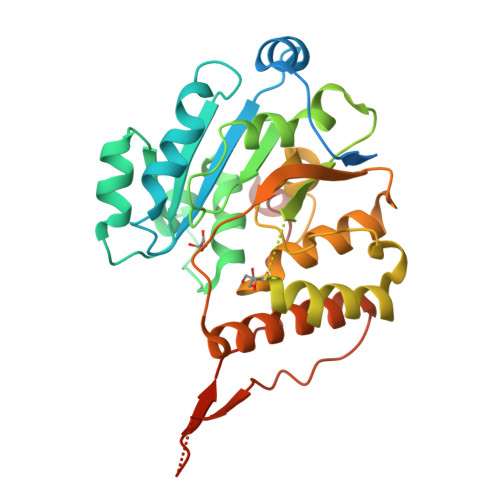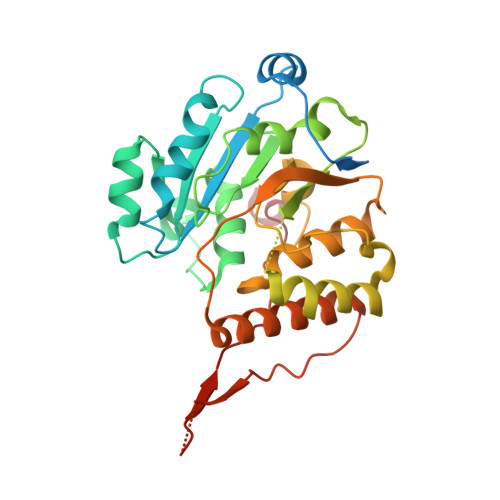Mechanistic insights into the retaining glucosyl-3-phosphoglycerate synthase from mycobacteria.
Urresti, S., Albesa-Jove, D., Schaeffer, F., Pham, H.T., Kaur, D., Gest, P., van der Woerd, M.J., Carreras-Gonzalez, A., Lopez-Fernandez, S., Alzari, P.M., Brennan, P.J., Jackson, M., Guerin, M.E.(2012) J Biological Chem 287: 24649-24661
- PubMed: 22637481
- DOI: https://doi.org/10.1074/jbc.M112.368191
- Primary Citation of Related Structures:
4DDZ, 4DE7, 4DEC - PubMed Abstract:
Considerable progress has been made in recent years in our understanding of the structural basis of glycosyl transfer. Yet the nature and relevance of the conformational changes associated with substrate recognition and catalysis remain poorly understood. We have focused on the glucosyl-3-phosphoglycerate synthase (GpgS), a "retaining" enzyme, that initiates the biosynthetic pathway of methylglucose lipopolysaccharides in mycobacteria. Evidence is provided that GpgS displays an unusually broad metal ion specificity for a GT-A enzyme, with Mg(2+), Mn(2+), Ca(2+), Co(2+), and Fe(2+) assisting catalysis. In the crystal structure of the apo-form of GpgS, we have observed that a flexible loop adopts a double conformation L(A) and L(I) in the active site of both monomers of the protein dimer. Notably, the L(A) loop geometry corresponds to an active conformation and is conserved in two other relevant states of the enzyme, namely the GpgS·metal·nucleotide sugar donor and the GpgS·metal·nucleotide·acceptor-bound complexes, indicating that GpgS is intrinsically in a catalytically active conformation. The crystal structure of GpgS in the presence of Mn(2+)·UDP·phosphoglyceric acid revealed an alternate conformation for the nucleotide sugar β-phosphate, which likely occurs upon sugar transfer. Structural, biochemical, and biophysical data point to a crucial role of the β-phosphate in donor and acceptor substrate binding and catalysis. Altogether, our experimental data suggest a model wherein the catalytic site is essentially preformed, with a few conformational changes of lateral chain residues as the protein proceeds along the catalytic cycle. This model of action may be applicable to a broad range of GT-A glycosyltransferases.
Organizational Affiliation:
Unidad de Biofísica, Centro Mixto Consejo Superior de Investigaciones Científicas-Universidad del País Vasco/Euskal Herriko Unibertsitatea, Barrio Sarriena s/n, Leioa, Bizkaia, 48940, Spain.



















